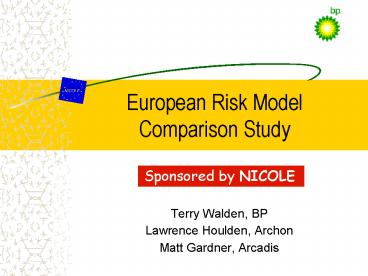European Risk Model Comparison Study PowerPoint PPT Presentation
1 / 17
Title: European Risk Model Comparison Study
1
European Risk ModelComparison Study
Sponsored by NICOLE
- Terry Walden, BP
- Lawrence Houlden, Archon
- Matt Gardner, Arcadis
2
Acknowledgements
- Sponsors
- Akzo Nobel
- BNFL
- BP
- Fortum
- ICI
- JM Bostad
- NICOLE
- Powergen
- SecondSite Property
- Shell Global Solutions
- Solvay
- Total
Peer Review Team
- SKB, Netherlands
- Kemakta, Sweden
- RIVM, Netherlands
- VITO, Belgium
Consultant
- Arcadis Geraghty and Miller, UK
3
Reasons for Study
- NICOLE and CLARINET advocate risk-based approach
to land management, but - Many member states develop own models
- Differences in model results can be orders of
magnitude - Poor understanding of differences may undermine
credibility of risk assessment
4
Objectives
- Compare human health risk models used in Europe
- Examine model results to explain output
differences - not to show which is better - Generic site with standardised inputs
- Real test cases using model defaults
- Limit comparison to dose or receptor point
concentrations - Risk comparison avoided because of different ways
countries handle toxicity (esp. cancer)
5
Countries and Models
- Austria No model
- Belgium (Flanders) Vlier-Humaan
- Denmark JAGG
- Finland No model
- France No model
- Germany UMS SISIM
6
Countries and Models (2)
- Greece No model
- Ireland No model
- Italy Guiditta ROME
- Luxembourg No model
- Netherlands HESP SUS Risc-Human
- Norway SFT 9906
7
Countries and Models (3)
- Portugal No model
- Spain LUR (Basque Country)
- Sweden Report 4639
- Switzerland Transim
- UK Consim RAM P20 CLEA
- Commercial RISC RBCA Toolkit
8
Soil Ingestion (Generic Site)
Cadmium Relative Dose (normalised to Vlier-Humaan)
9
Soil Ingestion Models
- All models have essentially the same soil
ingestion algorithms - In Vlier-Humaan, soil ingestion rates are fixed
(locked cell) at relatively low values - CLEA uses hard-wired probabilistic exposure at
95 level exposure 4x higher than most
models
10
Dermal Contact (Generic Site)
BaP Relative Dose (normalised to Risc-Human)
11
Dermal Contact Models
- CLEA has smaller dose as contaminant is allowed
to absorb plus volatilise from skin - Vlier- Risc-Human limits exposure to 2 hrs/day,
reflecting skin permeability - Risc-Human is very low because its soil-on-skin
adherence is fixed 10x lower than that in other
models
12
Soil to Indoor Air
Benzene concentrations in mg/m3
46
0.07
Note UMS concentration is 650x higher than RBCA
13
Indoor Air Soil Algorithms
- Flow thru cracks
- Flow thru concrete matrix
- Concrete weathering
- Indoor air 1 of soil gas
- User input for soil gas intrusion
- RISC RBCA Toolkit
- Vlier- Risc-Humaan
- JAGG
- UMS
- SFT 9906
RBCA allows for source depletion and averages
concentration over exposure duration
14
Generic Site Conclusions
- Soil ingestion and groundwater migration models
are all similar (one order magnitude) - Vegetable ingestion model results surprisingly
uniform (one order magnitude) - Dermal contact models more variable (two orders
magnitude) - Indoor air models, particularly UMS code, have
highest variability (3 orders magnitude) - Differences attributed to fixed parameters
(locked cells) or algorithms (indoor air)
15
Test Cases
- Lube plant with chlorinated plume
- Will show predicted vs. actual GW conc.
- Manufactured gas plant with PAHs in soil
- Will show soil ingestion results vs. generic site
- Fly ash landfill with heavy metals
- Chemical plant with chlorinateds pesticides in
soil - Petrol filling station with BTEX MTBE
16
Soil Ingestion Generic vs. Test Case
Relative Doses BaP Soil Ingestion
750
17
Overall Conclusions
- Consistent defensible results possible where fate
transport / chemical / exposure parameters well
understood - Where model defaults are used, significant
differences (3 orders magnitude) can occur, even
for simple soil ingestion case - Risk harmonisation in Europe will require
research on algorithms (dermal contact and indoor
air) better standardisation of exposure
parameters

